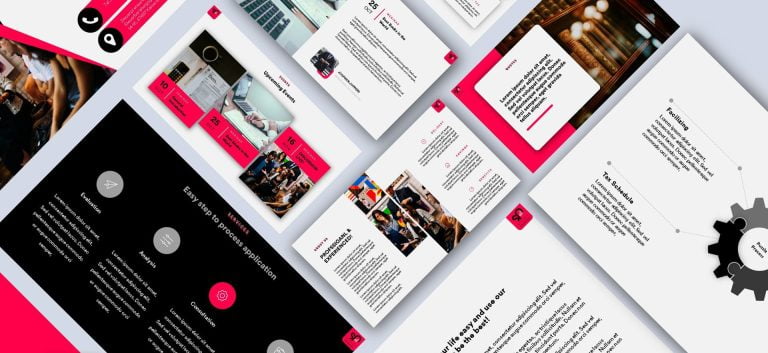We’ve all been there—standing in front of an audience, feeling our nerves take over, and struggling to deliver a compelling presentation. Whether it’s a lack of clear structure or difficulty engaging the audience, many of us face challenges when it comes to improving our presentation skills. These issues can hinder our ability to give a good presentation and connect with our audience effectively.
But what if there were simple, actionable steps you could take to transform your presentation skills into a successful presentation? From mastering body language to crafting effective visual aids, there are proven techniques that can help you deliver a good presentation with confidence.
Ready to captivate your audience and make your presentation memorable? Let’s dive into the essential tips that will elevate your next presentation to the next level.

The Foundations of Effective Presentation Skills
Mastering the art of delivering a compelling presentation begins with building a strong foundation. This involves honing the core presentation skills that ensure your message is clear, engaging, and memorable. Whether you’re giving a presentation to a small group or a large audience, understanding how to prepare thoroughly, create a comfortable learning environment, and manage your anxiety will set the stage for a successful presentation. By focusing on these key areas, you can improve your presentation skills and deliver an effective presentation that resonates with your audience.
Prepare Thoroughly
Preparation is the cornerstone of any good presentation. To deliver a presentation that connects with your audience and keeps them engaged, you must invest time in understanding your audience, conducting thorough research, and organizing your content effectively.
Understanding Your Audience:
Before you even begin crafting your presentation, it’s crucial to understand the needs, expectations, and interests of your target audience. Knowing who you’re speaking to allows you to tailor your message, choose relevant examples, and address any potential concerns your audience may have. This understanding helps you connect with your audience on a deeper level, ensuring your presentation is both relevant and impactful.
Conducting In-Depth Research
Once you’ve identified your audience, the next step is to dive deep into research. Effective presentation skills are rooted in knowledge, so gather reliable data, statistics, and insights that will support your key points. This thorough research not only enhances your credibility but also provides a solid foundation for the content of your presentation, making it informative and persuasive.
Structuring Your Content
With a clear understanding of your audience and comprehensive research in hand, it’s time to organize your content. A well-structured presentation is easier for your audience to follow and helps reinforce your key messages. Start with a strong introduction, follow with well-defined sections that flow logically, and conclude with a powerful ending that leaves a lasting impression. This structure will guide your audience through your presentation smoothly, making it easier for them to absorb and remember your points.
Create a Comfortable Learning Environment
An effective presentation doesn’t just rely on the content; the environment in which you present plays a significant role in how well your message is received. By setting the right tone and using environmental design to your advantage, you can create a space where your audience feels comfortable and focused.
Setting the Right Tone
The tone you set at the beginning of your presentation can determine how your audience responds to the rest of your message. Start with a welcoming and positive attitude, use friendly body language, and establish a connection with your audience right from the start. This approach helps you build rapport and keeps your audience engaged throughout the presentation.
Using Environmental Design to Enhance Focus
The physical environment where you present can either enhance or detract from your presentation. Consider factors such as lighting, seating arrangement, and the layout of your visual aids. A well-designed space with minimal distractions allows your audience to focus on your message, helping them stay engaged and retain more information. Whether you’re using slides, props, or other visual aids, ensure they are positioned and used in a way that supports your message and keeps your audience’s attention.
Manage Your Anxiety
Even the most experienced public speakers can feel nervous before a presentation. However, managing anxiety is crucial to delivering a compelling presentation with confidence. By adopting techniques to calm your nerves and practicing relaxation techniques, you can project confidence and keep your audience’s attention.
Techniques to Calm Nerves
To manage presentation anxiety, it’s important to develop strategies that work for you. Techniques such as deep breathing, positive visualization, and focusing on your message rather than your fears can significantly reduce anxiety. Additionally, remember that practice makes perfect; the more familiar you are with your material, the more confident you will feel.
Practicing Relaxation Techniques
Incorporating relaxation techniques into your preparation routine can help you maintain composure before and during your presentation. Simple practices like taking deep breaths, stretching, or even a brief meditation session can clear your mind and reduce physical tension. By entering the presentation with a calm and focused mindset, you’ll be better equipped to engage with your audience and deliver your message clearly and confidently.
Crafting an Engaging Presentation
Creating an engaging presentation is key to capturing your audience’s attention and keeping them invested in your message. A compelling presentation goes beyond just sharing information; it involves crafting a narrative that resonates, designing visuals that reinforce your points, and interacting with your audience in meaningful ways. By focusing on a strong beginning, incorporating universal design principles, creating dynamic content, and encouraging interactivity, you can ensure that your presentation is not only informative but also memorable.

Create a Strong Beginning
The beginning of your presentation sets the stage for everything that follows. To make a lasting impression, start with a powerful hook that grabs your audience’s attention and establishes your credibility.
The Power of a Hook
A strong hook is essential for engaging your audience right from the start. Whether it’s an intriguing question, a surprising statistic, or a compelling anecdote, your hook should immediately draw your audience in and make them curious to learn more. The goal is to capture their attention within the first few moments, setting a tone of anticipation and engagement.
Establishing Your Credibility
Once you’ve hooked your audience, it’s important to establish your credibility. Explain why you’re qualified to speak on the topic, whether through your expertise, experience, or unique perspective. Building credibility early on reassures your audience that they are in capable hands, making them more likely to trust your message and stay engaged throughout the presentation.
Incorporate Universal Design Principles
To ensure your presentation is accessible and inclusive, it’s important to incorporate universal design principles. This approach not only makes your presentation more effective but also ensures it reaches a broader audience.
Making Your Presentation Accessible
Accessibility is key to ensuring that all audience members, regardless of ability, can engage with your content. Use clear, legible fonts, high-contrast color schemes, and descriptive alt text for images. Additionally, consider providing captions or transcripts for any audio or video elements. By making these adjustments, you create an environment where everyone can participate fully in your presentation.
Utilizing Inclusive Visuals
Inclusive visuals are crucial for engaging a diverse audience. Avoid stereotypes and strive to represent a wide range of cultures, ages, and abilities in your visuals. When selecting images, graphics, or videos, ensure they resonate with different segments of your audience. This not only enhances inclusivity but also helps your audience connect with the content on a personal level.
Create a Dynamic Presentation
A dynamic presentation keeps your audience engaged by combining effective visual aids and well-organized slides that convey your message clearly and concisely.
Effective Use of Visual Aids
Visual aids are powerful tools for reinforcing your message and helping your audience retain information. Use visuals to complement your words, not replace them. Graphs, charts, and images should be simple yet impactful, directly supporting the key points you’re discussing. Avoid clutter and ensure each visual serves a clear purpose in your presentation.
Keeping Slides Concise
When it comes to slides, less is often more. Aim for concise, bullet-pointed slides that highlight key points rather than overwhelming your audience with text. Use each slide to emphasize specific aspects of your message, allowing you to elaborate verbally while keeping your audience focused on the main ideas. This approach ensures that your slides are a helpful guide, not a distraction.
Make Your Presentation Interactive
Interactivity is essential for maintaining audience engagement throughout your presentation. By encouraging participation and using tools like polls and Q&A sessions, you can create a more dynamic and engaging experience.
Encouraging Audience Participation
Encouraging your audience to participate actively in your presentation keeps them engaged and makes the experience more interactive. Ask open-ended questions, prompt discussions, or invite audience members to share their thoughts on the topic. This not only breaks the monotony of one-way communication but also helps you gauge the audience’s understanding and adjust your presentation accordingly.
Using Polls and Q&A Sessions
Incorporating polls and Q&A sessions is another effective way to interact with your audience. Polls can provide real-time feedback, making the audience feel involved in the presentation, while Q&A sessions allow for clarification and deeper exploration of topics. These tools make your presentation feel more like a conversation, encouraging active participation and helping to reinforce key points.
Include a Group Activity
Group activities are a powerful way to enhance learning and engagement during a presentation. They promote collaboration, deepen understanding, and make the content more memorable.
Benefits of Collaborative Learning
Collaborative learning through group activities fosters teamwork, encourages different perspectives, and helps solidify the material covered in your presentation. When participants work together to solve problems or discuss topics, they are more likely to engage deeply with the content and retain the information longer.
Examples of Effective Group Activities
Effective group activities might include small-group discussions, role-playing exercises, or problem-solving tasks related to the presentation’s topic. These activities should be carefully designed to reinforce the key points of your presentation while encouraging active participation from all group members. For instance, you could ask participants to brainstorm solutions to a challenge you’ve presented or analyze a case study in groups.
Address Key Points
To ensure your audience leaves with a clear understanding of your message, it’s important to address and reinforce the most important information throughout your presentation.
Highlighting the Most Important Information
Throughout your presentation, make sure to clearly highlight the most critical points. Use repetition, emphasis, and visual cues to draw attention to these key takeaways. Whether it’s through bullet points, summaries, or callouts, ensure your audience knows exactly what they should remember after your presentation.
Reiterating Key Takeaways
At the end of each section and the conclusion of your presentation, reiterate the key takeaways to reinforce your message. Summarizing these points not only aids in retention but also provides clarity, ensuring that your audience walks away with a strong understanding of the core concepts you’ve covered.
Delivering a Memorable Presentation
Delivering a memorable presentation requires more than just conveying information; it’s about creating an experience that resonates with your audience long after the presentation ends. To achieve this, focus on building confidence, mastering storytelling techniques, effectively utilizing multimedia elements, and incorporating humor strategically. These elements work together to engage your audience on multiple levels, making your presentation both impactful and unforgettable.

Confidence and Positive Body Language
Your body language plays a crucial role in how your audience perceives you and your message. Confidence, conveyed through positive body language, can significantly enhance the effectiveness of your presentation.
Maintaining Eye Contact
Maintaining eye contact is one of the most powerful ways to connect with your audience. It shows that you are confident and engaged, helping to build trust and rapport. Eye contact also allows you to gauge the audience’s reactions, enabling you to adjust your delivery in real time. Aim to make eye contact with various audience members throughout your presentation to keep them engaged and make them feel included.
Effective Use of Hand Gestures
Hand gestures can be used to emphasize key points and add energy to your presentation. Effective hand gestures should be natural and purposeful, helping to illustrate and reinforce your message. Avoid overly repetitive or distracting movements; instead, use gestures to highlight important information, signal transitions, or convey emotions. This not only adds dynamism to your presentation but also helps to keep the audience’s attention.
Storytelling Techniques
Storytelling is a powerful tool for making your presentation memorable and relatable. By crafting a narrative and incorporating anecdotes, you can engage your audience on an emotional level, making your message more impactful.
Crafting a Narrative
A well-crafted narrative gives your presentation structure and direction, helping to guide your audience through your key points. Start with a clear beginning, middle, and end, and weave your main message into a compelling story. This approach not only makes your presentation more engaging but also helps your audience to remember and relate to the information you’re sharing.
Using Anecdotes to Engage
Anecdotes are short, personal stories that can help to illustrate your points and make them more relatable to your audience. By sharing real-life examples or personal experiences, you can create an emotional connection with your audience, making your message more powerful and memorable. Choose anecdotes that are relevant to your topic and audience, and use them to highlight key messages or lessons.
Utilize Multimedia Elements
Incorporating multimedia elements like videos, images, and interactive tools can enhance your presentation by adding variety and visual interest. These elements can help to reinforce your message and keep your audience engaged.
Adding Videos and Images
Videos and images are powerful tools for breaking up text-heavy content and adding a visual dimension to your presentation. Use high-quality visuals that are relevant to your topic and help to illustrate your points. Videos can be particularly effective for demonstrating concepts, showing real-life examples, or adding a dynamic element to your presentation. Make sure that any multimedia you use is well-integrated into your presentation and supports your overall message.
Integrating Interactive Tools
Interactive tools like polls, quizzes, or live demonstrations can make your presentation more engaging and help to maintain your audience’s attention. These tools encourage participation and can provide immediate feedback, making the presentation feel more like a conversation than a lecture. Choose interactive elements that align with your content and enhance the learning experience for your audience.
Incorporating Humor Strategically
Humor can be a great way to make your presentation more enjoyable and relatable, but it must be used strategically to avoid undermining your professionalism.
Balancing Humor with Professionalism
When incorporating humor into your presentation, it’s important to strike the right balance between being entertaining and maintaining professionalism. Use humor to break the ice, lighten the mood, or make complex information more accessible, but avoid jokes that could be misunderstood or offend your audience. The key is to be lighthearted while still being respectful and staying on message.
Tips for Lightening the Mood
To effectively lighten the mood, consider using humor that is relevant to your topic and audience. This could include witty observations, light-hearted anecdotes, or playful commentary on common challenges related to your subject matter. Humor should feel natural and be used sparingly, so it enhances the presentation without overshadowing your key points. When done right, a touch of humor can make your presentation more engaging and help to build a stronger connection with your audience.
Step-by-Step Guide on How to Prepare an Effective Presentation
Preparing an effective presentation involves more than just compiling information and designing slides. It requires a strategic approach that ensures your content resonates with the audience, is well-researched, and is delivered confidently. This guide outlines the essential steps to prepare a presentation that not only informs but also engages and impresses your audience. By following these steps, you can refine your presentation skills and create a compelling, successful presentation.

Step 1: Understand the Audience and Their Needs
The first step in crafting an effective presentation is understanding your audience. Knowing who you are speaking to allows you to tailor your content to their interests, knowledge level, and expectations, ensuring that your message is relevant and impactful.
Start by analyzing your audience’s demographics, such as age, gender, education level, and professional background. This information helps you to gauge the type of language, examples, and references that will resonate with them. Understanding these demographics is crucial for crafting a presentation that feels personalized and relatable to your audience.
Once you have a clear picture of your audience, tailor your content to meet their expectations. Consider what they are hoping to gain from your presentation and address those needs directly. Whether your audience is looking for new insights, practical advice, or a deeper understanding of a topic, your presentation should be designed to deliver value that aligns with their goals.
Step 2: Conduct Thorough Research on the Topic
In-depth research is the backbone of any effective presentation. Gathering and organizing accurate, up-to-date information ensures that your content is credible and comprehensive.
Begin your research by identifying and gathering information from reliable sources. Use academic journals, reputable websites, and expert opinions to build a solid foundation for your presentation. Ensure that all the data and references you use are current and relevant to your topic, as outdated information can undermine your credibility.
Once you have collected your research, organize it in a way that supports your presentation’s structure. Categorize the information based on key themes or points, and ensure that you can easily access and reference it as you build your presentation. This organization helps in crafting a clear, logical flow in your content.
Step 3: Organize the Content with a Clear Structure
A well-structured presentation guides your audience through your content smoothly, making it easier for them to follow and understand your key messages.
Begin by drafting an outline of your presentation. Start with an introduction that captures attention, followed by a body that covers your main points in a logical sequence, and conclude with a strong summary that reinforces your key messages. This outline serves as the backbone of your presentation, ensuring that each section transitions smoothly into the next.
As you organize your content, ensure that there is a logical flow from one point to the next. Each idea should naturally lead to the next, creating a cohesive narrative that guides the audience through your presentation. This logical progression not only enhances understanding but also helps in maintaining the audience’s interest.
Step 4: Develop Visually Appealing and Supportive Visual Aids
Visual aids are crucial for reinforcing your spoken words and keeping your audience engaged. They should be designed to complement and enhance your message, not overwhelm it.
When designing your slides, focus on clarity and simplicity. Use consistent fonts, colors, and layouts to create a professional appearance. Avoid cluttering your slides with too much text; instead, use bullet points, keywords, and visuals to support your points. Each slide should convey a single idea clearly and concisely.
Graphics and charts can be powerful tools for illustrating complex data or concepts. Use them to simplify and visualize information that might be difficult to convey with words alone. Ensure that all visuals are relevant to your content and are easy to understand at a glance. Proper use of these elements can make your presentation more engaging and memorable.
Step 5: Practice, Practice, and Practice
Rehearsal is key to delivering a polished presentation. The more you practice, the more confident and smooth your delivery will be.
Practice delivering your presentation within the allotted time. Use a timer to ensure that you can cover all your points without rushing or exceeding your time limit. This practice helps you to refine your pacing and ensures that you can deliver a concise and focused presentation.
Recording yourself while practicing allows you to review your performance and identify areas for improvement. Pay attention to your tone, body language, and pacing, and make adjustments as needed. This self-evaluation can help you to fine-tune your presentation and increase your confidence.
Step 6: Seek Feedback and Make Necessary Adjustments
Feedback is invaluable for refining your presentation. It provides insights into how your content is received and where improvements can be made.
Before your final presentation, seek feedback from colleagues, friends, or mentors. Encourage them to provide honest, constructive criticism on your content, delivery, and visual aids. This feedback can highlight areas that need clarification or enhancement, helping you to fine-tune your presentation.
Take the feedback you receive and make the necessary adjustments to your presentation. This might involve clarifying certain points, refining your slides, or altering your delivery style. Implementing these changes ensures that your presentation is as effective and polished as possible.
Step 7: Prepare for Potential Technical or Logistical Issues
Even the best-prepared presentations can be derailed by technical or logistical issues. Being proactive in addressing these potential problems can save you from unnecessary stress and ensure a smooth delivery.
Always have a backup plan in place for your presentation. This could include bringing printed handouts, having a copy of your presentation on a USB drive, or preparing a backup device. Being prepared for unexpected issues helps you to stay calm and focused if something goes wrong.
Before your presentation, test all the equipment you will be using, such as projectors, microphones, and laptops. Ensure that everything is working correctly and that you know how to troubleshoot common problems. This preparation minimizes the risk of technical glitches and ensures that you can deliver your presentation without interruptions.
9 Effective Techniques to Deliver a Memorable Presentation
Delivering a memorable presentation requires more than just presenting information; it involves engaging your audience and making a lasting impact. To achieve this, incorporate techniques that enhance your delivery, maintain audience interest, and effectively communicate your message. Here are nine effective techniques to help you deliver a presentation that stands out and resonates with your audience.

Technique 1: Confidence and Positive Body Language
Projecting confidence and using positive body language can significantly enhance your presentation. Your non-verbal cues often communicate more than your words, and demonstrating confidence helps establish credibility and engage your audience.
Projecting confidence involves standing tall, speaking clearly, and maintaining a steady, assured tone. Confidence is contagious and can help to build trust with your audience. Practice your posture and voice control to project authority and assurance, making you appear more credible and engaging.
Body language can be a powerful tool for emphasizing your key points and making your message more compelling. Use purposeful gestures to highlight important ideas and reinforce your message. Ensure that your movements align with your spoken words to create a cohesive and dynamic delivery.
Technique 2: Eye Contact with the Audience
Eye contact is crucial for building a connection with your audience and conveying sincerity. It helps to establish rapport and makes your audience feel involved and valued.
Making genuine eye contact involves looking at different audience members throughout your presentation, rather than focusing on a single spot. This approach helps to create a sense of personal connection and engagement, making your audience feel more included in the presentation.
Avoid common eye contact mistakes such as staring at your notes or screen for extended periods. This can make you appear disengaged or unprepared. Instead, aim to make brief but frequent eye contact with various members of the audience to maintain engagement and demonstrate your attentiveness.
Technique 3: Effective Use of Hand Gestures and Movement
Hand gestures and movement can enhance your delivery by adding emphasis and energy to your presentation. They help to illustrate and reinforce your key points, making your message more engaging.
Use hand gestures to emphasize key points, illustrate concepts, or convey emotions. Gestures should be natural and purposeful, helping to draw attention to important aspects of your presentation. Avoid overly dramatic or repetitive gestures, as these can distract from your message.
Be mindful of movements that may distract or detract from your message. Avoid fidgeting, pacing excessively, or making repetitive gestures that do not add value to your presentation. Focus on using gestures that support and enhance your message, keeping the audience’s attention on your key points.
Technique 4: Utilize Storytelling Techniques
Storytelling can transform your presentation from a series of facts into a compelling narrative. It helps to engage your audience on an emotional level and makes your message more memorable.
Incorporate stories that are relevant to your topic and resonate with your audience. Personal anecdotes, case studies, or real-life examples can help to illustrate your points and make your presentation more engaging. Stories create a narrative that guides the audience through your content, making it more relatable and impactful.
Ensure that the stories you share align with your key message and support your main points. Stories should be used to reinforce your content, not distract from it. By aligning your stories with your message, you create a cohesive and compelling presentation that reinforces your key takeaways.
Technique 5: Incorporate Multimedia Elements
Multimedia elements, such as videos and interactive tools, can enhance your presentation by adding variety and visual interest. They help to illustrate your points and keep your audience engaged.
Video clips can be an effective way to demonstrate concepts, show real-life examples, or add a dynamic element to your presentation. Choose high-quality, relevant videos that complement your content and help to reinforce your message. Ensure that videos are well-integrated into your presentation and do not disrupt the flow.
Interactive polls and quizzes can engage your audience and provide immediate feedback. Use them to involve your audience in the presentation, gather their opinions, or test their understanding of the material. Interactive elements make your presentation more dynamic and participatory, helping to maintain interest and engagement.
Technique 6: Utilize Humor Strategically
Humor can be a powerful tool for making your presentation more enjoyable and relatable. However, it must be used strategically to enhance your message without undermining your professionalism.
Incorporate light humor to break the ice, lighten the mood, or make complex information more accessible. Use humor that is relevant to your topic and audience, and ensure that it enhances rather than distracts from your message. Light humor can help to create a positive atmosphere and make your presentation more memorable.
Ensure that your humor is appropriate for the context and audience. Avoid jokes or references that could be misunderstood or offend your audience. The goal is to use humor to enhance your presentation while maintaining a professional and respectful tone.
Technique 7: Practice Active Listening and Respond to Feedback
Active listening and responsiveness to feedback can significantly enhance the effectiveness of your presentation. Engaging with your audience and adapting to their reactions ensures that your presentation meets their needs and interests.
Encourage audience participation and listen to their questions or comments. Engaging with your audience helps to build rapport and demonstrates that you value their input. Be open to their feedback and adjust your presentation as needed to address their concerns or interests.
Be prepared to adapt your presentation based on audience feedback or reactions. If you notice signs of confusion or disinterest, adjust your delivery or content to better align with your audience’s needs. Flexibility and responsiveness are key to maintaining engagement and ensuring the effectiveness of your presentation.
Technique 8: Apply the 10-20-30 Rule
The 10-20-30 Rule is a simple guideline for creating and delivering presentations that are concise and effective. It helps to ensure that your presentation is focused and engaging.
The 10-20-30 Rule, created by Guy Kawasaki, suggests that a presentation should have no more than 10 slides, last no longer than 20 minutes, and use a font size of at least 30 points. This rule helps to keep your presentation concise, focused, and visually accessible.
To implement the 10-20-30 Rule, design your presentation with a maximum of 10 slides, ensuring that each slide covers a single key point. Keep your presentation within 20 minutes to maintain audience attention and provide a concise overview of your content. Use large, readable fonts to ensure that your slides are easily accessible and engaging.
Technique 9: Implement the 5-5-5 Rule
The 5-5-5 Rule is another effective guideline for creating presentations that are clear and engaging. It focuses on the design and content of your slides to ensure they are effective and engaging.
The 5-5-5 Rule suggests that each slide should have no more than 5 lines of text, with each line containing no more than 5 words. This rule helps to keep your slides clear, concise, and easy to read, ensuring that your audience can quickly grasp your key points.
Applying the 5-5-5 Rule helps to eliminate clutter and ensures that your slides are visually accessible. By keeping text to a minimum, you encourage your audience to focus on your spoken words rather than reading dense text. This approach helps to enhance understanding and engagement, making your presentation more effective.
FAQs
How to Start a Presentation?
Begin with a compelling hook to grab attention. Clearly state your purpose and outline what the audience will gain. Establish your credibility and set a positive tone for the presentation.
How to End a Presentation?
Conclude with a strong summary of key points and a clear call to action. Reinforce your main message and thank the audience for their time. Leave them with a memorable takeaway.
How to Make a Presentation Interactive?
Engage your audience with questions, polls, and discussions. Encourage participation through interactive elements like quizzes or group activities. This keeps the audience involved and enhances learning.
How to Create a Presentation with Venngage in 5 Steps
- Sign up for a Venngage account.
- Choose a template that suits your presentation needs.
- Customize the template with your content and visuals.
- Add interactive elements and adjust the design.
- Download or share your presentation.
What are some tips for giving a good presentation?
Some effective presentation tips include rehearsing your presentation, using clear and engaging presentation slides, arriving early to set up, and involving the audience to help keep them engaged.
Why are presentation skills important in professional settings?
Good presentation skills are important as they help convey your message clearly, enhance your credibility, and engage your audience effectively, which is essential for a successful career.
How can I improve my presentation skills?
To improve your presentation skills, practice regularly, seek feedback from peers, study effective speakers, and focus on developing your stage presence and self-confidence.
What constitutes a killer presentation?
A killer presentation includes a clear structure, engaging visuals, strong delivery, the ability to connect with the audience, and effective use of pauses to emphasize key points.
How can I use note cards effectively during a presentation?
Note cards can help you stay organized and ensure you cover all your talking points. Use them thoughtfully to guide your presentation without reading directly from them.
What should I do if I experience stage fright before a presentation?
To combat stage fright, practice deep breathing to increase oxygen to your brain, visualize success, and rehearse your presentation multiple times to build self-confidence.
What are the best practices for creating effective presentation slides?
Best practices for effective presentation slides include keeping text minimal, using high-quality images, ensuring readability, and aligning slides with your talking points to enhance understanding.
How can I engage the audience during my presentation?
You can involve the audience by asking questions, encouraging discussions, using interactive elements, and addressing their interests to keep them engaged throughout your presentation.
What should I focus on to start my presentation with a bang?
To set the tone and start your presentation with a bang, consider opening with a compelling story, a surprising statistic, or a thought-provoking question to capture your audience’s attention immediately.
How can I effectively rehearse my presentation?
To rehearse effectively, practice in front of a mirror or record yourself, seek feedback from others, and time your presentation to ensure it fits within the allocated time while allowing for pauses.






